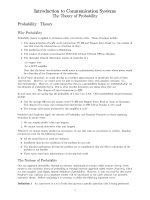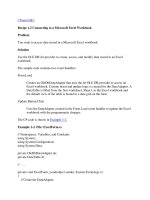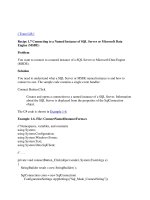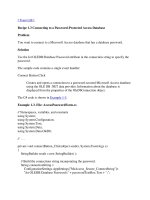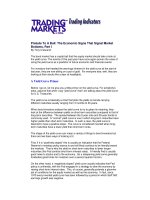Tài liệu Prelude To A Bull The Economic Signs That Signal Market(pdf) doc
Bạn đang xem bản rút gọn của tài liệu. Xem và tải ngay bản đầy đủ của tài liệu tại đây (22.5 KB, 3 trang )
Prelude To A Bull: The Economic Signs That Signal Market
Bottoms, Part I
By Tony Crescenzi
The bond market has a crystal ball that the equity market should take a look at:
the yield curve. The events of this past year have once again proven the value of
using the yield curve as a predictor of future economic and financial events.
For investors that heeded the warnings inherent in the yield curve at the start of
last year, they are now sitting on a pot of gold. For everyone else, well, they are
looking at their stocks like a deer at headlights.
A Yield Curve Primer
Before I go on, let me give you a little primer on the yield curve. For simplicity’s
sake, assume that when I say “yield curve” that I am talking about the yield curve
for U.S. Treasuries.
The yield curve is basically a chart that plots the yields on bonds carrying
different maturities usually ranging from 3 months to 30 years.
When bond investors analyze the yield curve to try to glean its meaning, they
look at the difference between yields on short-term securities compared to that of
long-term securities. The spread between the 2-year note and 30-year bonds is
commonly used. A “normal” yield curve is one in which long-term maturities have
higher yields than short-term maturities. In such a case, the yield curve is
deemed to have a positive slope. The curve is considered inverted when long-
term maturities have a lower yield than short-term ones.
The shape of the yield curve can mean a variety of things to bond investors but
there are two basic ways of looking at it.
First, if it is “positively sloped” this is usually an indication that the Federal
Reserve’s monetary policy stance is and will likely continue to be friendly toward
the markets. That is why the yield on short-term maturities is lower longer
maturities (the Fed controls short-term interest rates). A friendly Fed is usually
good news to stocks and to the economy. So a steepening yield curve generally
forebodes good times for investors over a several quarter horizon.
On the other hand, a “negatively sloped” yield curve usually indicates that Fed
policy is unfriendly, with the Fed engaged in a strategy to slow the economy by
raising short-term interest rates. This, of course, generally portends a gloomier
set of conditions for the equity market as well as the economy. In fact, since
1970 every inverted yield curve has been followed by a period in which S&P 500
earnings growth was negative.
The yield curve is thought to be a better predictor of the economy than the stock
market and can therefore give you an edge if you follow it. Indeed, studies have
shown that the yield curve predicts economic events roughly 12 months or more
in advance while the stock market is thought to foretell events 6 to 9 months in
advance.
The Yield Curve Foretold the Events of 2000
The events of 2000 were forewarned by the inversion of the yield curve at the
start of the year in January when it inverted for the first time in about ten years.
While many investors and analysts dismissed the inversion as related to
technical factors such as Uncle Sam’s buy-back of the national debt (which
entails the purchase of long-dated maturities, mostly), there were clearly other
reasons for the inversion that had implications for the markets and the economy.
First of all, the inversion was occurring because the bond market was beginning
to believe that the Fed would have to raise rates aggressively to slow the
economy. That’s exactly what happened; the Fed raised rates one full
percentage point over the next four months. In turn, bond investors began to
believe that economic growth would decelerate.
It did.
Stock investors took time to heed the yield curve’s message that the Fed would
put its chokehold on the economy but it didn’t take all that long. It is probably no
coincidence that the Dow Jones Industrial Average peaked the same month the
yield curve inverted. The S&P 500 and the Nasdaq peaked just a couple of
months later in March.
The Current Situation
So what is this crystal ball telling us now?
For starters, note that the yield curve became positively sloped for the first time in
almost a year on December 9, 2000. The return to a positive slope has a few
implications for the markets and the economy. First and foremost it indicates that
the markets expect the Fed to be friendlier toward the markets. Indeed, the Fed
has already turned friendly toward the markets having announced a surprise rate
cut on January 3. Moreover, the bond market is priced for nearly 150 basis
points of additional rate cuts this year.
Second, as a result of the expectation for future Fed rate cuts, the bond market
believes the economy will regain its footing again after a period of weakening.
This view is reinforced by the notion that the Bush administration will be
successful in pushing through a tax cut this year.
Both the rate cut and tax cut hope also augurs well for the stock market because
they typically boost economic growth, thereby boosting corporate earnings.
Lower interest rates, of course, also reduce the competition for capital, as
investors flee lower yielding interest rate products and move stocks where
returns are usually much higher.
The increased hope for a friendlier Fed is already helping cyclical companies
including basic materials companies such as Dupont, International Paper, and
Caterpillar. Retailers and technology companies have also started to gain
despite continued weak fundamentals. All of these companies have one thing in
common: hope that the Fed will cut rates and thereby invigorate the expansion
and boost corporate profits.
If these hopes are fulfilled, we will be able to look back and say that the yield
curve called it. Again. The yield curve warned in 2000, "Don't Fight the Fed." In
2001, that message is being sent again, but with an entirely new meaning.
There are other means by which the bond market can help you to spot key
turning points in the stock market and the economy. I will discuss this in my next
lesson.
Copyright © 2001 by TradingMarkets.com, Inc.

